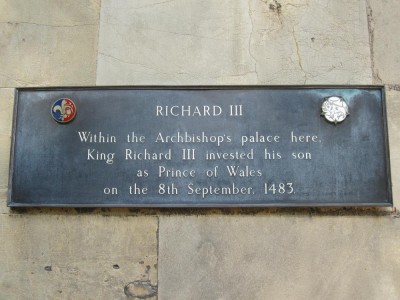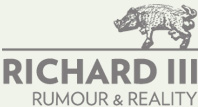Investiture of the Prince of Wales

The site of Edward of Middleham's investiture as Prince of Wales is still marked in York today
© Carolyn Donahue
Associated people
Associated institutions
Dates
9th August 1483Description
Richard III's triumphant visit to York in August and September 1483 was filled with feasts, processions, pageantry and celebration. The highlight was the investiture of his son, Edward of Middleham, as Prince of Wales.
The ceremony took place at the Archbishop's Palace, Richard's residence during his stay at York, after six o'clock on the evening of 8 September 1483. The king performed the ritual, girding the boy with a sword and placing a cap of estate on his head, a gold ring on his finger and a golden staff in his hand. The confirmation of Edward's new title was witnessed by the Dean of the Minster, Robert Booth, along with numerous canons, prebendaries, parsons and vicars as well as the lords who were visiting the city as part of the royal entourage.
The ceremony was followed by a four hour banquet at the Archbishop's Palace during which the king and queen wore their crowns throughout. The king's son had been created Prince of Wales on 24 August 1483 by his father at Nottingham, less than a week before the royal family arrived in York. This was a traditional title held by a monarch's eldest son and so was a celebration of Richard III's position as king as well as the elevation of his heir.
The spectacular investiture at York also saw knighthoods conferred on the king's natural son, John of Pontefract, and his nephew, Edward earl of Warwick, son of the duke of Clarence. A ceremonial investiture as prince of Wales was not essential to bearing the title, but had been held for previous recipients. Richard's choice of York for the event was unusual and is striking, indicating the important role he envisioned for his son in the north of England.
Sources
Investiture ceremony, 8 September 1483
York Minster Library, Vicars Choral Statute Book, p. 48, transcript in P.W. Hammond and A.F. Sutton, Richard III The Road to Bosworth Field (London, 1985) pp. 140-41.
Creation of Edward of Middleham as Prince of Wales, 1483
British Library Harley MS 433 f. 26v, translation from the Latin printed in R. Horrox and P.W. Hammond (eds.) British Library Harleian Manuscript 433 (Upminster, 1979-82) vol 1 p. 83
Investiture of the Prince, 8 September 1484
N. Pronay and J. Cox (eds.) The Crowland Chronicle Continuations: 1459-1486 (London, 1986) p.161

